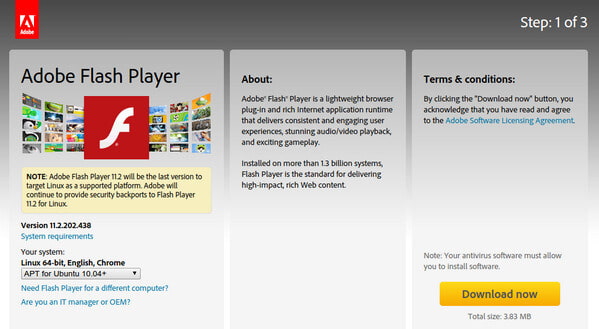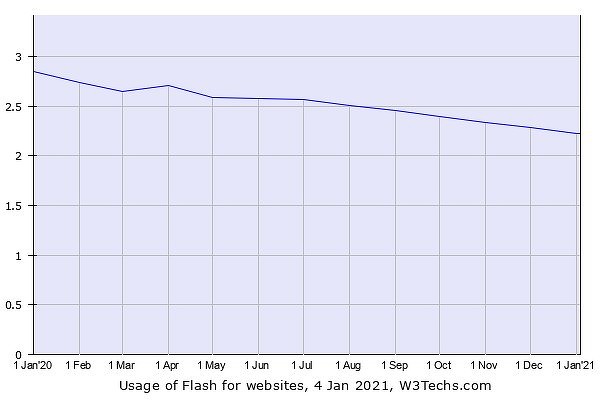

- #ADOBE FLASH PLAYER 13 FOR MAC NOT WORKING UPDATE#
- #ADOBE FLASH PLAYER 13 FOR MAC NOT WORKING PATCH#
“So security will improve, but if the CISO doesn’t manage it correctly, there could be push back”įrom the CISO’s perspective, is this a positive, as it is one less thing to apply patches to? Quentyn Taylor, director of information security at Canon Europe, told Infosecurity that CISOs will not have to do much in this instance, as there will be a patch to disable it and work by browser vendors will end support also.
#ADOBE FLASH PLAYER 13 FOR MAC NOT WORKING UPDATE#
What is the best case scenario? Mackey said users will see a message that Flash is “no longer supported” rather than an option to download or update it. So will Janube a Y2K moment for Flash player faults? Mackey said there is the danger of phishing emails capitalizing on the end of support offering rogue downloads from malicious websites, or even malware masqueraded as the Flash player fix, “if the user believes that Flash should be enabled and is not recognizing the browser has disabled it.”

Add to that the money being paid out in bug bounties by Adobe, and the end of support could be a serious cost saving. Mackey also said the end was likely brought about due to a lack of support for Flash from Apple devices, and it was part of a three-stage challenge for Adobe: the challenge of supporting Flash and creating its security fixes, the roll out of the iPhone and iPad and a lack of support, and hiring new developers who have an interest in working with 20+ year-old software. He believed that there were a large number of websites still using Flash though, and those “are tremendously behind the times” and Flash is still seen in visually active websites, specifically gaming. Speaking to Infosecurity, Tim Mackey, principal security strategist at the Synopsys CyRC, said he could recall a time when there were weekly Flash updates, and he was “happy to see Flash go into a museum of internet technology.” However, the end of support is likely to bring about some threats the NCSC advisory warned of “Fake Flash” trojans as having been a popular method of compromising unsuspecting web users. Laforge also said if a website that uses Flash migrates to open web standards, “you shouldn’t notice much difference except that you will no longer see prompts to run Flash on that site.” “For years, the Flash Player plugin was a ripe target for bug hunters, requiring regular updates” Google Chrome product manager Anthony Laforge said it has “taken a lot of close work with Adobe, other browsers and major publishers to make sure the web is ready to be Flash-free.” Specifically, Adobe said it will stop updating and distributing the Flash Player at the end of 2020 and encourage content creators to migrate any existing Flash content to the more modern open formats.Īs for the browsers, Microsoft said by the end of 2020, it will remove the ability to run Adobe Flash in Microsoft Edge and Internet Explorer across all supported versions of Microsoft Windows, and users will no longer have any ability to enable or run Flash.

“Many sys admins will be breathing a sigh of relief, as for years the Flash Player plugin was a ripe target for bug hunters, requiring regular updates,” said NCSC device security researcher Josh D. So come January 1, if you’re still running Flash, it is unlikely your laptop is going to explode, whether you’re hosting or visiting Flash, and at worst, the website or frame will not load. According to an NCSC advisory, users will likely not even notice when Flash disappears, as long as they are using a modern browser receiving regular updates.

In particular, vulnerabilities in Flash have allowed attackers to compromise targets through adverts and distribute ransomware in just two instances. It’s fairly easy to see why – this updates page shows 292 fixes in the last 14 years. In fact, web developers have had over two years to prepare for the end of support, as it was announced in July 2017 by Adobe that the Flash Player would no longer be supported after December 2020. These options have come to replace it in order to provide a better online experience than the text only options which preceded its use. Over the years it has faced numerous security fixes and faced the challenge of newer options such as HTML5, WebGL and WebAssembly. It’s not like this has come as a surprise though. This veteran concept of rich internet content is facing its retirement on New Years’ Eve, and come January 1 2021, there will be no more support for it. As we enter December, we also enter the last month of support for Adobe’s Flash software.


 0 kommentar(er)
0 kommentar(er)
